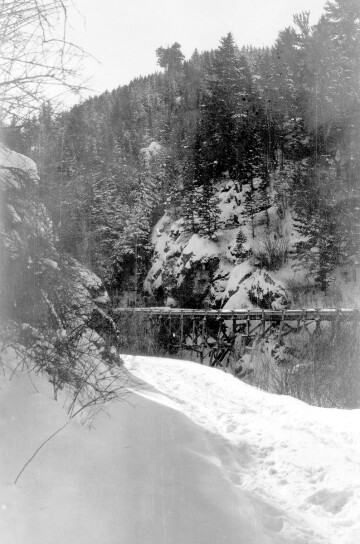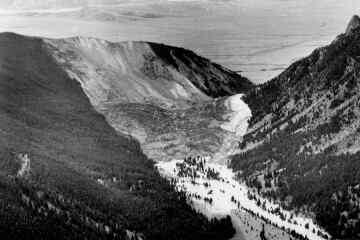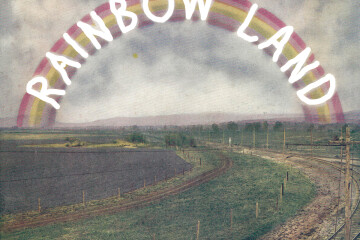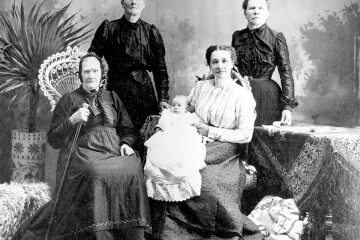Life in Bear Canyon: Logs, Dancing & Steam Engines
Today, Bear Canyon is generally quiet and peaceful. A dirt road gently winds up the canyon, passing homes, outbuildings, and barns. New World Gulch Trail begins where the road ends, leading adventurous hikers, equestrians, and mountain bikers on a six-mile trek to Mystic Lake. Today’s Bear Canyon and the surrounding area hides a fascinating past. An incredible variety of industries, institutions, and activities have contributed to the unique history of this eastern edge of Gallatin County.
Life in the Bear Canyon/Mount Ellis area began early with the establishment of Fort Ellis. In April of 1867, John Bozeman and Thomas Cover left the Gallatin Valley and travelled east toward Fort C.F. Smith, hoping to secure flour contracts with the U.S. Army. According to the official story at the time, the two men were in camp one night along the Yellowstone River when a small party of Blackfeet approached. As the story went, John Bozeman was killed in the ensuing skirmish, but Tom Cover survived, sparking a debate about what actually happened that night. Regardless of who killed John Bozeman, citizens of Bozeman City requested (and were granted) a nearby military fort. Construction of Fort Ellis began in the fall of 1867 on military reservation land a couple of miles east of town. Fort Ellis was located just west of todays I-90 Bear Canyon Exit (the Frontage Road now bisects the area).
The Fort’s first commanding officer was Captain R. S. LaMotte, who supervised the construction of the first buildings and surrounding stockade. LaMotte’s command drew to a close just two years later, when his infantry force was replaced with four cavalry companies. Though Captain LaMotte’s residence in the Gallatin Valley was short-lived, his name was given to LaMotte School, which opened in 1894 and is still operating today at a location near the entrance to Bear Canyon.
Industry reached Bear Canyon during the railroad’s arrival in Montana in the 1880s. Early Bozeman businessman Walter Cooper began logging in the canyon to supply the Northern Pacific with railroad ties. Cooper established several logging camps in the Gallatin Valley, including the one in Bear Canyon. While his logging operation in the Gallatin Canyon was much larger, Cooper did build an impressive flume in Bear Canyon that stretched from Bear Lake to Moffit Canyon.
Isaac (Ike), and Phill Alldritt were lumbermen who also operated out of Bear Canyon in the early 20th Century. Isaac was born in 1855 in Illinois. According to Bozeman’s City Directory of 1892-93, Alldritt arrived in Montana in 1880. He married Mary Copple in Gallatin County and their son Phill was born in the early 1890s. As a young adult, Phill helped operate the Park Lumber Company in Bear Canyon with his father.
In 1920, the Alldritts purchased an Avery steam engine for use at the sawmill site at Park Lumber Company, but it took another year for the engine to be transported to the camp. According to a 1970 Bozeman Daily Chronicle article titled “Monument to Bygone Age,” local resident John Carolus agreed to move the engine four miles up New World Gulch to Park Camp’s sawmill. Carolus was paid $100 for his trouble, but the four-mile trip up the mountain took 10 days.
Unfortunately, the engine’s use at the lumber camp proved to be short-lived. After only a few years, the lumber operation at Park Camp ceased due to the prevalence of damaged timber. About ten years earlier, in the summer of 1910, forest fires raged across the Northern Rockies, including parts of western Montana and the Gallatin Valley. The well-documented forest fires of 1910 culminated in a massive conflagration as the winds picked up on August 20. By the 23rd, rain and snow in the higher elevations slowed the burning in Montana, Idaho, and Washington. As the Alldritts discovered, even years later the timber in Bear Canyon proved to be too badly damaged for logging, ending Ike and Phill’s hopes of establishing a lumber empire in the canyon.
The Alldritts’ engine sat idle for the next 50 years, trapped in Bear Canyon’s New World Gulch at the foot of Mount Ellis. In March of 1972, Forsyth, Montana resident Don Bradley and a hearty crew of volunteers forged a path up the gulch to the engine, and as the Bozeman Daily Chronicle reported, returned “the engine to civilization again.” Thanks to modern machinery, the Avery’s trip down the mountain took four hours instead of ten days. The steam engine finally made it all the way to Forsyth, and was restored.
Besides logging operations, Bear Canyon was also home to an optimistic gold prospector or two in the late 19th Century. Miner Henry Guilford occupied a small cabin in the canyon while he searched for gold in his nearby mine shaft. As the Chronicle reported in the 1970 article, “Monument to Bygone Age,” the one-legged Guilford was known to locals by his nickname, “Step and a half.” Guilford’s life remains somewhat of a mystery. According to his obituary that appeared in the Bozeman Courier on March 26, 1943, Guilford was born in 1854 in Iowa. He came to the Bozeman area from the Black Hills of South Dakota in 1891.
Several other families called the Bear Canyon/Mount Ellis area home, including the Greens, Murphys, Martinz, and Hoells. One local resident, Maude Sharp Hoell, treasured her memories of growing up in Bear Canyon. Maude was born in 1902 in Iowa, but her family moved to the Gallatin Valley in 1910. She attended LaMotte School and made friends with other local children, including the Hoells, Jenkins, Woods, and McCallisters. In her memoir, Recollections of 94 Years (prepared by Susan Metcalf in 1996), Maude remembered the time when her friend Elsie Phipps fell in a logging flume:
There was a flume made out of wood to float logs down Bear Canyon. Logs were loaded on a freight train at the overpass. The water in the flume moved very fast to carry large logs, and Elsie was almost out of grabbing distance when someone snagged the hem of her dress.
The Bear Canyon/Mount Ellis area was a close-knit community, and its residents knew how to have a good time. “When Maude [Hoell] was young, their entertainment was dancing. People would have dances and everybody brought food. They always had a big Christmas dance when they danced until three or four in the morning. LaMotte School always had a big Christmas program and a huge Christmas tree.” Maude Sharp married Bill Hoell in March of 1930, and the couple made their home in Bear Canyon, where Maude spent the majority of her life.
In 1902, another school, Mount Ellis Academy, joined LaMotte to provide education in the area. Run by the Seventh-Day Adventist Church, Mount Ellis is still operating today as a private boarding school. In the 1970s, students at the school enjoyed a ski program at the local Bear Canyon ski hill and went to work improving the nearby recreation area by repairing the chair lift. The Bear Canyon Ski area actually began several decades before Mount Ellis acquired the property. In the 1930s, skiing became Bear Canyon’s major claim to fame. Members of the fledgling Bozeman Ski Club enjoyed the near-perfect downhill skiing slopes, and installed a home-made rope tow and ski jumps.
In addition to skiing, several clubs were established in the area and fostered a sense of community. The Rocky Creek 4-H Club taught local children valuable skills outside of the classroom and provided them with a social outlet. For fun, Rocky Creek 4-Hers went on picnics around Gallatin County and even constructed elaborate floats for Bozeman parades. The Fort Ellis Woman’s Club started in 1925 as a way to bring together the ladies of Bear Canyon, Fort Ellis, and Kelly Canyon. The women met once a month to swap stories, discuss local events, support charities, and enjoy refreshments. Dues money purchased greeting and sympathy cards for members, and each year the remaining money went to a local charity. The Fort Ellis Woman’s Club disbanded in 2005, after 80 years of fun.
Bear Canyon is a quieter place now. Fort Ellis closed in 1886, its buildings dismantled or moved to other locations. Downhill skiing at Bear Canyon gradually declined as the larger Bridger Bowl ski area increased in popularity in the 1960s and 70s. However, signs of the past still remain—place names, abandoned buildings and equipment high in the mountains, and an enduring sense of community pride.



